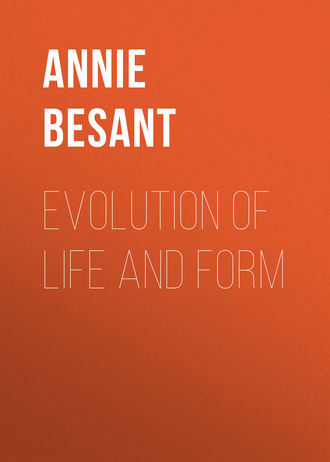 полная версия
полная версияEvolution of Life and Form
The scientific man of antiquity, then, began by that self-attention, unfolding in himself one by one all those potentialities under a suitable Guru, passing from step to step till he reached the highest, and ever worshipping the Mahâguru, the Guru of the universe. Having unfolded his highest powers, he began to study life, life in its outpouring, not life in its manifold and veiled manifestations in the lower worlds. Hence the lofty point at which he started, no less than the arising of Íshvara enveloped in Mâyâ.
What is Íshvara? What is Mâyâ? There is the first great problem. Let us reverently address ourselves to it. The philosophers of India have answered these questions in different ways, each one containing part of the eternal truth. Íshvara is that mighty centre of consciousness that exists unchanged in the bosom of the One Existence. There are innumerable such Centres of Consciousness, of which you may remember your own Svâmi Subba Rao wrote as existing in the bosom of the One Existence. Íshvara in manifestation is like a lamp, a light enclosed in a shade. Íshvara, enveloped in Mâyâ, brings forth a universe and is enclosed, as it were, in the universe of which He is the Light. Breaking the shade, the light shines forth in every direction. Dissolving the universe, He still remains. The centre remains, but the circumference that circumscribed it is gone. So is that mighty centre when the universe vanishes; He alone remains, holding His centre unshaken in the very act of merging in, expanding into, the Infinite, the Absolute, the Super-Consciousness, the One. Let us think of Him as an eternal centre of self-consciousness, able to merge in super-consciousness and to again limit Himself to self-consciousness.
What, then, is Mâyâ? Mâyâ is prepared in every case by the merging in Íshvara of the whole of the universe which is come to its ending. As one loka rolls up and merges in the one above it, all forms in the loka thus merged disappear, but the consciousness that ensouled those forms does not vanish; a modification of consciousness remains, a modification expressing itself by a vibratory power – not a vibration, but a power to vibrate in a particular way; and though the form vanishes as the loka is merged in the one above it – because the matter disappears, being disintegrated into finer matter – in consciousness there remains the power to vibrate in the way in which it had vibrated in the grosser matter, and power persists although the forms caused by such vibrations disappear, for lack of material sufficiently coarse to respond to such vibrations. As one region passes into the next, this process is repeated over and over and over again, and loka after loka vanishes. The forms are gone, the vibrations are gone, only the modifications in consciousness capable of giving rise to similar vibrations remain until finally, when Íshvara – whose consciousness was the one consciousness in the universe, whose life was the one life, who supported every form, who made the possibility of every separated existence – gathers up His universe into Himself ere He merges Himself in the One, everything has vanished that we know as form, nothing remains save the centre of consciousness. There remains in Íshvara the power of vibrating in particular fashions, resulting from the evolution of His universe, in endless multiplicity of vibrations; when He merges Himself in the One Existence all has vanished as form, but powers remain in these subtle modifications, preserved in that unchangeable centre in the mightiness of the One Life. Is that only a dream?
There was a great teacher, Vâsiṣhtha. He taught Râmâ, as you will remember, and in the record of his teaching there are hints on some of the mysteries of life. If you keep what I have now said in mind, if I have succeeded by the clumsy words which are all that the human tongue can utter on these great problems, in clarifying at all your thoughts, then just listen to that same thought as expressed by Sûryadeva, when he was speaking of the same thing – the ending and the new beginning of a universe. We have only to add to what I have already said, that when Íshvara arises in order that a new universe may be formed, He throws His life into these modifications that had apparently disappeared, and the Mâyâ in which He arises, enveloped and circumscribed, is His own re-vivified memory, which can never be separated from Himself; He draws in His consciousness, under the impulse of the Great Breath, limiting it to self-consciousness, and turning His attention to the contents of that self-consciousness, its powers start into activity, and that is Mâyâ. So it is written: "Thereafter, Thou, O Lord, intent on [maintaining] the reign of night, fixed within the Self, having indrawn that order of things, [or universe.]… To-day, Thou hast awakened, and art most joyfully desirous of again throwing out [manifesting] the universe in mighty gradations [hierarchies of beings]." [Yoga Vâsiṣhtha, lxxxvii, 7, 8.] These nights and days are the "Nights and Days of Brahmâ," the inbreathing and outbreathing of the One Existence, and Mâyâ is this indrawn "order of things" that remains fixed through the Night, and starts forth as Íshvara awakens at the coming of Day. That is Mâyâ and if you take up the definitions given in the different schools, you will find that this includes and illumines every one of them, that it shows you what is meant by illusion, and explains to you what is implied in dreaming. The joyful throwing out into manifestation of all the powers that are remembered by Íshvara the moment His attention is turned to His own Self, that memory-prompted "desire" which arises in the bosom of the Eternal, is the root of the coming universe. Now this thought will prove to you the key of much ancient teaching. You have, in the Universal Mind full of ideas which are not yet concreted into phenomena, the world of ideas of Plato, the invisible world of the Hebrew Kabbalah; in every great teaching you find the same thought expressed. If, instead of being fettered by words, as for the most part we are, and if, instead of repeating phrases that carry with them no idea in the mind of the repeater, we would try to read the thought that underlies the words, we should find the Hindu philosophy in every modern philosophy that is worthy of the name, and see the traces of ancient India in Greece and in Rome, in Germany and in the England of to-day.
What is the next stage? The Life-Breath goes forth. Íshvara, the Centre of all, enveloped in Mâyâ sends forth His breath; as that vibrating breath falls on the enveloping Mâyâ, Mâyâ becomes Prakriti, or Matter – rather, perhaps, Mûlaprakriti, the root of matter. As that breath, with its triple vibratory force falls on this matter, it throws it into three modifications, or "attributes" – Tamas, inertia, or better, stability; Rajas, activity, vigour; Sattva, a difficult word to translate: I am inclined to translate it as Harmony; for this reason, that wherever there is pleasure, Sattva is present. Without harmony no pleasure can anywhere exist. All pleasure is due to harmonious vibration, and that quality of harmonious inter-related vibrations is the quality that Sattva gives to matter. These three fundamental qualities of matter – answering to three fundamental modifications in the consciousness of Íshvara – inertia, activity, and harmony, these are the famous three Gunas without which Prakriti cannot manifest. Fundamental, essential, and unchangeable, they are present in every particle in the manifested universe, and according to their combinations is the nature of each particle.
Then comes the seven-fold division. In a moment I will tell you why we speak of it as seven-fold instead of five-fold, which is the more familiar division to you. The seven-fold division, what is this? Here is matter with its three Gunas, now ready to receive another impulse from the Life-Breath; that breath comes forth from Brahmâ, for Íshvara has unfolded His triple nature into its three aspects, and it comes forth in seven great waves. Each one modifies matter, and evolves and ensouls those that follow it. The first two are absolutely beyond our knowing, and belong not to our present stages of evolution at all; therefore they are ordinarily left out, and only the five that make up the evolution of our universe are spoken of in the sacred books. Here and there the seven are mentioned, but only rarely. You may remember the seven tongues of fire, for instance, and one or two other similar phrases. But generally five-fold is Prâna, the five-fold evolving life. First, in every case, is a modification of consciousness sent forth as a power by Íshvara. Turn to the Vishnu Purâna and you will see exactly the stage that I am pointing out to you in more modern phrases. Íshvara Himself, as Brahmâ, sends forth a power, due to a modification of His consciousness, called in the Vishnu Purâna a Tanmâtra. In the English translation the word rudiment is used. You remember the rudiments of sound, of touch, of colour, and so on. All these rudiments are the tanmâtras. These tanmâtras are the powers due to modifications in consciousness or life, without which no modification in matter can be. The consciousness first, then the form. The first great vibration that goes forth is the vibration that gives rise to what we speak of here as sound – all our terms being drawn from the lowest, or physical, manifestations; the form that it brings into manifestation is A'kâsha, the mighty element of Ether; not the ether of modern science, of course, although that is its physical representative. Then into that the next tanmâtra, the next power due to a modification of consciousness, is sent forth; the A'kâsha, with the primary vibration within it, receives the second vibration sent out by Íshvara, and this, pervading the matter around it, brings about the next modification of matter, the element Vâyu, or Air. Vâyu, permeated, ensouled and enveloped in A'kâsha, receives a fresh impulse from Íshvara, the third tanmâtra, or power resulting from a modification of consciousness; this tanmâtra, working on Vâyu, produces the modification of matter called the element Agni, or Fire, and this fire-matter is permeated, ensouled, and enveloped in Vâyu, as Vâyu in A'kâsha. A similar process brings into manifestation the elements Apas and Prithivî. The "magnetic field" of an atom is composed of all the tanmâtras and elements above it. Try to realise this process if you can, though I know the conception is difficult. What has occurred? A modification of life or consciousness in Íshvara, manifested as a power, a vibration; everything depends on vibration; ancient and modern science speak alike on this. The universe is made up of vibrations, the vibrations which are the modifications of the Divine outpouring of life. These clothe themselves in fundamental forms of matter, out of which all multiplicity is developed. These modifications in matter, these great, or primary, elements are also called tattvas. Tanmâtras, then, are the powers sent out by modifications of consciousness, and these are awkwardly translated by the word rudiments; we have next the modifications in matter, the great elements, the primary elements, or tattvas. The first of the tattvas is called A'kâsha; then Vâyu, then Agni, then Apas, then Prithivî, the five following one after the other; the keynote of this evolution is that the modification of the previous higher tattva is reproduced within the lower, pervades it and expands outside it. If you will take the Vishnu Purâna, the second chapter, and read over again the evolution of the five tattvas, you will find that the Sanskrit word which is used comes from a root which means to pervade as well as to enclose, giving the idea of permeation as well as of expanding around to form an envelope. And you must understand that the central life of each tattva is the preceding tattva with its tanmâtra; that, with the new tanmâtra, makes up the life; and the outer form is the new tattva that by that productive action comes into existence.
Now leaving that, for I cannot go into further details, let me just say to you one word about the seven and the five, because that has been a source of great dispute between some of our Hindu Pandits and some of our Theosophists. In the universe, taken as a whole, seven-fold is the life of Íshvara. Beyond the tattva that we know as A'kâsha, there is that tattva which has been called Anupâdaka, and beyond that A'ditattva, the first. Those are far beyond our knowing; we cannot think so far. For our life-evolution, the five mark the limit; and only the five, therefore, as a rule, are given in the books which are to be studied to show you how to evolve.
Rapidly we must pass onward, then, to these tattvas as, modifying themselves by aggregations, and by disintegrations and re-combinations of these, they make innumerable forms. The fundamental conception is that there are as many basic forms of atoms in the universe as there are tattvas. The tattva of ancient science is the atom of modern science, but modern science makes the mistake of supposing that there is only one fundamental atom. The truth is that modern science is only seeking to get hold of the Prithivî Tattva, the lowest, or physical, atom, and it has not yet recognized even the existence of the four (or six) higher atoms that stretch beyond. These atoms form the regions of the universe. All that is physical is made up from the Prithivî Tattva. Not only is this so, but within the limits of this physical region, correspondences of all the higher six atomic forms are reproduced. The sub-divisions of the physical region, due to combinations of the Prithivî Tattva, show forth the characteristics of the great regions which make up the universe; so that we have here in our solid, liquid, gas, three ethers and atoms, correspondences of the six higher tattvas, but we have them all in their Prithivî form; they are the modifications of Prithivî, reproducing on a lower plane the great primary elements. We might call them Prithivî A'ditattva, Prithivî Anupâdhakatattva, Prithivî A'kâshatattva, Prithivî Vâyutattva, Prithivî Agnitattva, Prithivî Apastattva, Prithivî Prithivîtattva. Above the region of Prithivî comes the great realm of Apas, with similar sub-divisions, all of the Apastattva, and so again another seven above that in the higher realm of Agni, and above that the same in the still higher realm of Vâyu, and above that again in the A'kâsha, and then the highest two unknown realms. When you remember that all these regions interpenetrate the one the other, you will gain some glimpse of a complexity dizzying to think of, the vast complexity of the universe in which the One Life is working. Yet that complexity is simplified by thus working downwards, and there is the line of the study of the ancient science. Working out from this originally simple life into the endless multiplicity of forms, we may trace the One among the many, and see the Self in all things, and all things in Him.
At the ending of a universe, the tattvas merge in each other by disintegration; Prithivî Tattva, having disintegrated into atoms, these atoms are themselves broken up, and the tanmâtra that formed them, being no longer able to express itself for lack of suitable material, ceases to be a power, and remains only represented by a modification in consciousness – a permanent possibility. Thus Apas Tattva becomes the lowest manifestation, and, by a repetition of the above process, ceases to exist. In like fashion each successively vanishes. Hence, Mahâdeva is represented as saying in the Shivâgama: "The universe proceeded from the tattvas; it goes on through the tattvas; it vanishes into the tattvas."
Such is the grandiose conception of the kosmos given by the science of antiquity; one life, pulsing into innumerable vibrations, and these throwing matter into forms. On this was based the Pythagorean system of numbers; on this mathematics and music were founded; on this the "Great Science," or Magic, of long-perished nations was built up. That science only survives in its purity in the Great White Brotherhood, but its traces may yet be seen in the scriptures and the religions of the world.
We take up modern science, and pass into a different atmosphere. Now phenomena are to be studied, forms are to occupy our attention. But as we look at modern science we find that it is beginning to transcend the study of forms; we find the efforts of its greatest men are turned to seek unity amid diversity. Do not think that, in speaking of modern science as studying forms, I am indifferent to the mighty achievements that it has made, or that I would say one word in derogation of the ability of the leading men of science, and the priceless value of the work that they are doing for humanity. Their achievements during the present century are achievements that are worthy of the very deepest respect, not only for the "sublime patience of the investigator," of which William Kingdon Clifford so rightly spoke, but also for the self-abnegation with which many of them have given their lives to follow truth, to study in the innermost recesses of the phenomena of nature what secrets she has hidden, what may be underneath the "Veil of Isis." I do not, then, speak a word against modern science, but I point out to you this fact, that the greatest work of science has been the generalisations that have been suggested in the attempt to reach simplicity, to reduce multiplicity to unity. How far has science gone from that generally accepted view of the materialistic school of thirty years ago, that the universe is made up of an indefinite number of atoms, the atoms being our chemical elements! A phrase from one of the most famous of the then leading men of science, Dr. Ludwig Büchner, will mark the greatness of the change: he declared that the carbon atom will always remain a carbon atom, and has been a carbon atom from all eternity; that the hydrogen atom from all eternity has been a hydrogen atom, and to all eternity a hydrogen atom it will remain; for atoms with their properties are indestructible, and are therefore eternal. What man of science would dare to allege that to-day, knowing that he would be laughed to scorn by all his scientific brethren; who would say that these atoms are eternally of the same nature as they have till now been made out to be? What is science in fact, doing as to the atom? It is finding in what is called the atom a composite body, a compound, not an element. This discovery is chiefly due to the researches of Sir William Crookes, who is guided in his investigations by a deeper philosophy of the universe than is common among scientists. It is gradually finding out that these atoms are things that are built up gradually, and that the qualities of atoms are not fixed, but are properties that change with every difference of conditions. Late investigations have shown that when chemical bodies are submitted to extraordinary conditions of cold – such cold as makes the air into a liquid and solidifies hydrogen and oxygen – they suffer the destruction of their supposedly permanent properties. It is proved that, as these conditions are changed, and as lower and lower ranges of temperature are brought to bear upon these chemical elements, one by one their eternal properties disappear, and they lie there changed in their activities, and lose the characteristic traits which enabled them to be discovered as parts of the moving world. Downward and downward falls the temperature, property after property disappears, until science asks, bewildered, what will happen when we reach the absolute zero, what will then become of the properties of matter, what will remain of the characteristics of the elements? Is there not but one Matter, and are not all chemical elements but modifications, aggregations, of this one ultimate matter? Similarly with Force, modern science has made the magnificent generalisation that all the forces that we know are modifications of one Force, and are identical in their essential nature; that heat, and light, and all the various forces around us, electricity, magnetism and the rest, that all these are but vibrations of varying lengths and activities in a subtle medium, and that they may be transmuted the one into the other. They are not fundamentally different, but are one and the same in their root. But if this be so, if there be but one Matter, if there be but one Force, then science is now tending towards unity; and as that unity is traced or aimed at, science will have to pass out of the grosser realm of dense matter into the realm of forces working in subtle media; and we find this wondrous change that, whereas in old days the existence of force was argued for inductively, by studying the changes in matter, now science is beginning to posit the existence of force and to question whether matter is anything more than the action of force. Instead of regarding an atom as a solid indivisible particle, the tendency is to regard it as a vortex of energy, a centre of force. One writer even goes so far as to suggest that an atom is a source "through which an invisible fluid is pouring into three-dimensional space." Other atoms, "anti-atoms," may be "sinks" through which the fluid pours out. If these unite, may not inertia be neutralised as well as gravity? May there not be potential matter, and may there not be such in space, without any of the attributes which characterise matter, but ready to be vivified and form a system of worlds? Here we have H. P. B.'s atoms and laya centres, put forward tentatively as a scientific problem. Science is mounting into the invisible world and is trying to measure and to weigh that which therein it finds. Now this tendency to unity is the testimony to the One that underlies all manifestation; only one Force, only one Matter; endless diversity of forces, transmutable into each other; endless diversity of forms, which break up again to recombine; only one Force under all forces, one Matter under all forms. It is seen that the very fact of harmony and of evolution points to a root unity, and that eternally independent self-moving particles would only perpetuate a chaos.
As science travels along this most hopeful line, we find great changes are arising in the nature of the studies that are being carried on, and we have that wonderful theory of Sir William Crookes of the genesis of the elements. He takes protyle as a starting-point, which is really Vâyu in its form on this physical plane – Prithivî Vâyu – and out of that builds one atom after another, making all the chemical elements to be bodies aggregated together by the action of a positive and a negative force. Let me just remind you of this, because some amongst you go so eagerly after modern science and despise your own literature. If you had read your Vishnu Purâna, with your brain, and not merely with your eyes through modern spectacles, you might have learnt that theory of Sir William Crookes long, long before he gave it. He has drawn a picture, and the picture shows an immovable axis, and around it a spiral coil, and at points in that coil are atoms of the chemical elements, generated by that coil which represents a swinging and cooling force. That spiral is in the great ocean of protyle, or primeval matter, and, as that spiral goes round and round the immovable axis, it generates chemical elements one after another, and so brings into existence the materials out of which the world is to be formed. That is the dry scientific statement summarised from his own address. But I have read in an ancient book of a mountain – which is the emblem of stability, of an axis round which everything is to revolve – thrown into a mighty ocean; and I have read of a great serpent turned round that mountain in spiral coils; on the one side the Suras are pulling and on the other side the Asuras are equally busy. Between the two – the positive and negative of modern science – evolution is started and the serpent spiral begins to turn and turn round that axis. They call the axis Mount Mandara, and they call the spiral coil the serpent Vâsuki while the axis rests on Hari as a pivot; they call the positive and the negative forces the Gods and Demons, and their churning of the ocean gives rise to the materials of the universe. Aye! That is from the seer, who, looking at the ocean of matter, described pictorially what the eyes of the spirit beheld there; while the other is the dry scientific statement of the modern thinker, who works out his magnificent generalisation as the result of his study of the forms. The seer and the scientist have met.
I shall show you, when I come to deal with life, that modern science is coming towards our view of life. I shall give you, from the latest declarations of our modern scientific teachers, points which will show you how they are climbing towards the ancient view which is found in our sacred books; and I will now finish this first part of our subject this morning by one plea addressed to all of you, which I would pray you to think over at your leisure.








